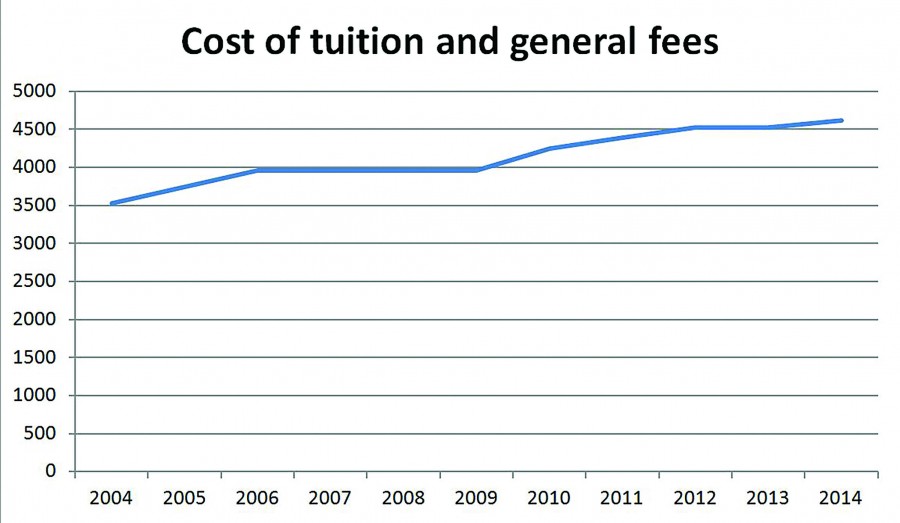Proposed senate bill may lower cost of attendance
This graph shows the total cost of tuition and general fees for in-state students taking 12 – 16 credits per semester between 2004 and 2014 at the University of Toledo, according to the UT Office of the Treasurer’s financial brochures.
April 15, 2015
Filed under News, Top Stories
In the Ohio Senate, a bill has been introduced that would challenge universities in Ohio to lower the cost of in-state student attendance by five percent in 2016-2017 academic year.
The bill was proposed by State Senator Keith Faber, president of the Ohio Senate (R-Celina).
“My colleagues and I in the Ohio Senate issued the Ohio Senate ‘Five Percent Challenge’ asking Ohio’s public colleges and universities to reduce student costs by five percent for the next academic year,” Faber said in an email interview. “We believe five percent is a very realistic goal, and the legislature is ready to help them achieve it.”
We’re looking at more aggressive, or as the state would call it, intrusive advising, injecting ourselves into the students’ lives more early on and throughout their career here.”
— Rhonda Wingfield, Director of the Office of Financial Planning, Analysis and Budget
According to Faber, the bill is intended to challenge universities “to think outside of the box” and reduce costs of attendance without decreasing the quality of the education or making direct cuts in tuitions.
The University of Toledo has already organized a committee dedicated to putting together such a plan if Faber’s proposed bill passes.
According to Rhonda Wingfield, director of the Office of Financial Planning, Analysis and Budget and a member of the committee, the group is made up of representatives from faculty, the provost’s office, finance, student affairs and several other offices.
Wingfield said that because the bill has not been passed yet, it is hard to develop a fully-realized plan about the possible cuts; however, Wingfield said UT is looking into creative ways to lower the cost for students to attend UT.
“So for us, and for many of us in Ohio, there’s really not a lot to cut because we have held our tuition low,” Wingfield said. “So we’re looking at more creative ideas, how we can help our students graduate on time, complete quicker, helping our students with advising services. We’re looking at more aggressive, or as the state would call it, intrusive advising, injecting ourselves into the students’ lives more early on and throughout their career here.”
Wingfield said UT is not considering cuts in tuition and general fees as a part of this five percent challenge.
“We’ve held our tuition low for so many years, a five percent reduction would be a real hardship to the university,” Wingfield said.
Student Government President Clayton Notestine said he thinks UT doesn’t need to suffer more cuts than it already has.
“There are some universities that need the five percent decrease more or less than others,” Notestine said. “The University of Toledo has had its tuition frozen for several years, when other universities were raising their tuition. This is the first year in a long time, other universities are trying to freeze their tuition and UT isn’t, so we’re different in that regard.”
According to the UT Office of the Treasurer’s Finance Brochures, from 2004 to 2014 UT tuition and general fees per semester for in-state full-time students (12-16 credit hours) have increased by 31%. Last year UT only increased tuition by 2.5%.
“If you’re for the 5 percent cuts, then I hope that you enjoy the leaks that happen in the library,” Notestine said. “If you want your education to be less expensive, I understand, I had to pay for my education too; however, I’m not sure if I’m willing to go ahead and get a cheaper education at the expense of cheaper academic experience.”
Wingfield said UT will explore options such as reducing the number of credits required to graduate, offering discounts to students that complete 30 credits a year and reducing the costs of classroom materials like textbooks.
“I think the goal of what the state is proposing is something that the university is very much in favor of and we are always doing whatever we can to make sure the cost of higher education to students is as low as possible but while ensuring the highest quality,” said Jon Strunk, associate vice president of university communication and UT spokesman.
Notestine said his major concern with a five percent cut is that valuable services at UT might be cut in order to reduce costs.
“You get what you pay for, I suppose,” Notestine said. “I think that if students on this campus are concerned about the price of their education, which they should be, they shouldn’t be asking for a five percent cut in tuition or anything.”
Wingfield said a five percent cut would affect the university and the students, but UT is doing what it can to assure these cuts minimally affect the overall integrity of student life.
“We’ve made great efforts to already reduce the costs, but of course we can always do more and we’ve been working towards that for quite some time,” Wingfield said. “So we’re looking at that plan and looking at what we can we do without affecting the students’ well-being and welfare.”










